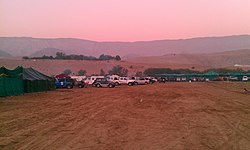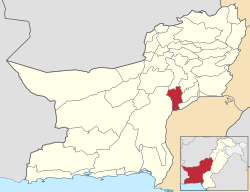Jhal Magsi District
This articleneeds additional citations forverification.(October 2017) |
Jhal Magsi District
ضلع جھل مگسی جهل مگسی دمگ | |
|---|---|
 Panorama of Jhal Magsi | |
 Map of Balochistan with Jhal Magsi District highlighted | |
| Country | |
| Province | |
| Division | Nasirabad |
| Headquarters | Gandawah |
| Government | |
| • Type | District Administration |
| •Deputy Commissioner | Syed Rahmatullah |
| • District Police Officer | N/A |
| • District Health Officer | N/A |
| Area | |
| • Total | 3,615 km2(1,396 sq mi) |
| Population (2023) | |
| • Total | 203,368 |
| • Density | 56/km2(150/sq mi) |
| Time zone | UTC+5(PST) |
| Number ofTehsils | 2 |
Jhal Magsi District(Urdu:ضلع جھل مگسی) is adistrictin the central part of theBalochistanprovince inPakistan.[1]It is purely Baloch area previously part ofKachhi District,it was established as a district of its own in December 1991 and after a brief period in which it was known asKachhi(the remainder of the old Kachhi district being renamed toBolan), its name was changed toJhal Magsiin May 1992.[2]The district is named after the town ofJhal,seat of theMagsitribe.[3][4]
The district has two main towns, Gandawah, the administrative centre andJhal Magsi;and is divided into two subdivisions: Gandawah and Jhal Magsi. The City is also known for ancient places and tourist attractions like Peer Chattal Shah Noorani, Taj Mahal of Balochistan (Moti Gohram Tomb), Moola River, Peer Lakha and more.
Demographics
[edit]At the time of the2023 census,the district had a population of 203,368.[5]
At the time of the 2023 census, 75.43% of the population spokeBalochi,16.33%Sindhi,5.76%Saraikiand 2.09%Brahuias their first language.[7]
Administrative divisions
[edit]Jhal Magsi District is administratively divided into twotehsils,Jhal MagsiandGandawah;with one sub tehsil (Mirpur). Both subdivisions have a different administrative history.
It had nine Union Council in 2012, but last year four Union Council were added by the Local Government Department at recommendation of Deputy Commissioner/Delimitation Officer. Namely, the union councils of Jhal Magsi District are as under:
- Gandawah Tehsil
- Union Council Gandawah
- Union Council Khari
- Union Council Patri
- Mirpur Sub Tehsil
- Union Council Mirpur
- Jhal Magsi Tehsil
- Union Council Jhal Magsi
- Union Council Hathiari
- Union Council Panjuk
- Union Council Kot Magsi
- Union Council Barija
- Union Council Mat Sindhur
- Union Council Safrani
- Union Council Saifabad
- Union Council Akbarabad
Education
[edit]According to thePakistan District Education Rankings2017, district Jhal Magsi is ranked at number 108 out of the 141 ranked districts in Pakistan on the education score index. This index considers learning, gender parity and retention in the district.
Literacy rate in 2014–15 of population 10 years and older in the district stood at 25% whereas for females it was only 11%.[8]
Post primary access is a major issue in the district with 84% schools being at primary level. Compare this with high schools which constitute only 5% of government schools in the district. This is also reflected in the enrolment figures with 7,553 students enrolled in class 1 to 5 and only 118 students enrolled in class 9 and 10.
Gender disparity is another issue in the district. Only 33% schools in the district are girls’ schools. Access to education for girls is a major issue in the district and is also reflected in the low literacy rates for females.
Moreover, the schools in the district lack basic facilities. According toAlif AilaanPakistan District Education Rankings2017, the district is ranked at number 142 out of the 155 districts of Pakistan for primary school infrastructure. At the middle school level, it is ranked at number 141 out of the 155 districts. These rankings take into account the basic facilities available in schools including drinking water, working toilet, availability of electricity, existence of a boundary wall and general building condition. More than 200 out of the 301 government schools in the district do not have electricity, toilet and a boundary wall. 139 schools do not have clean drinking water.
The main issues reported inTaleem Do! Appfor the district is the unavailability of teachers in schools.
References
[edit]- ^"Tehsils & Unions in the District of Jhal Magsi - Government of Pakistan".Archived fromthe originalon 2012-03-26.Retrieved2011-01-10.
- ^PCO 2000,p. 1.
- ^PCO 2000,p. 6.
- ^Ansari, Sheikh Sadik Ali Sher Ali (1901).The Musalman Races found in Sind, Baluchistan and Afghanistan.pp. 61–113.
- ^https:// pbs.gov.pk/sites/default/files/population/2023/tables/balochistan/dcr/table_1.pdf
- ^https:// pbs.gov.pk/sites/default/files/population/2023/tables/balochistan/dcr/table_9.pdf.
{{cite web}}:Missing or empty|title=(help) - ^https:// pbs.gov.pk/sites/default/files/population/2023/tables/balochistan/dcr/table_11.pdf
- ^Pakistan Bureau of Statistics (2016).Pakistan Social and Living Standards Measurement Survey 2014-15.[online] Islamabad: Government of Pakistan, p.111. Available at:http:// pbs.gov.pk/sites/default/files//pslm/publications/PSLM_2014-15_National-Provincial-District_report.pdf[Accessed 6 Aug. 2018].
Bibliography
[edit]- 1998 District census report of Jhal Magsi.Census publication. Vol. 72. Islamabad: Population Census Organization, Statistics Division, Government of Pakistan. 2000.

